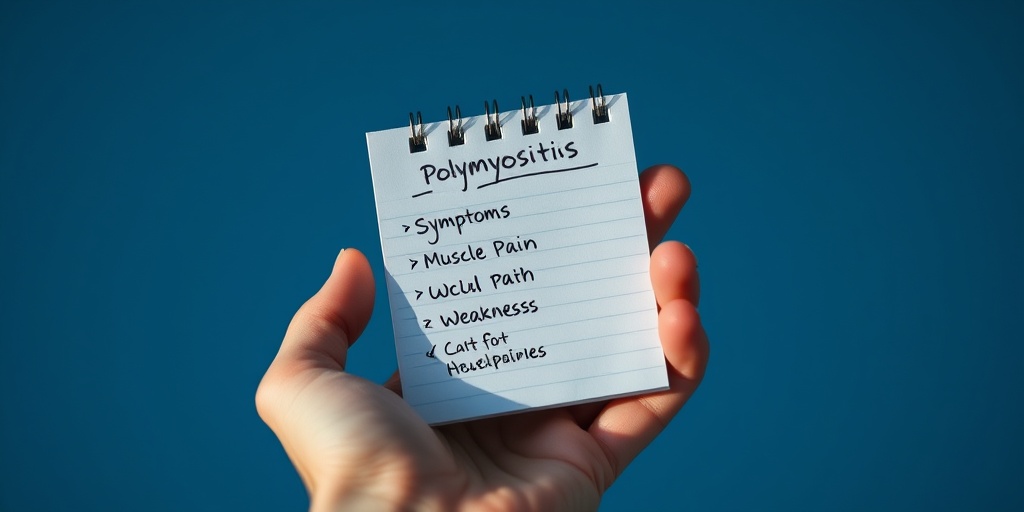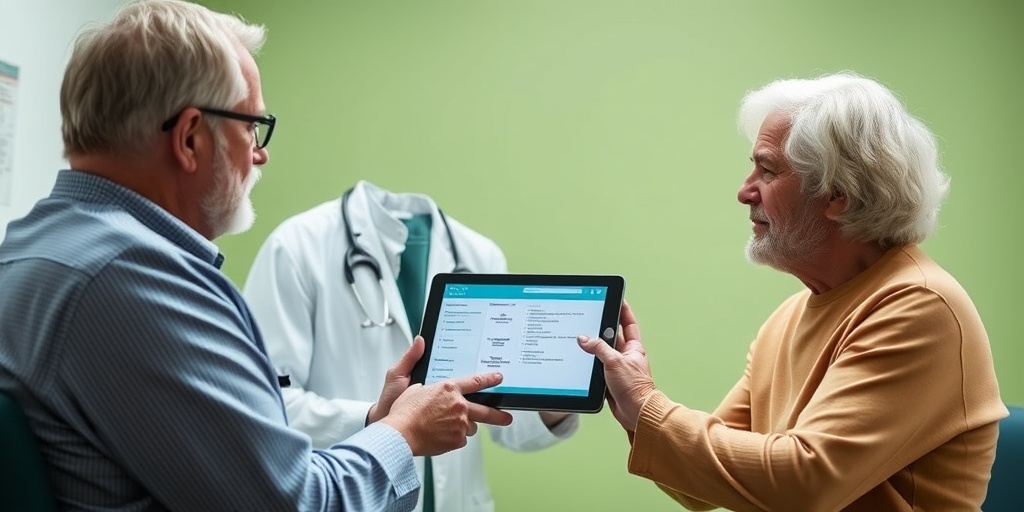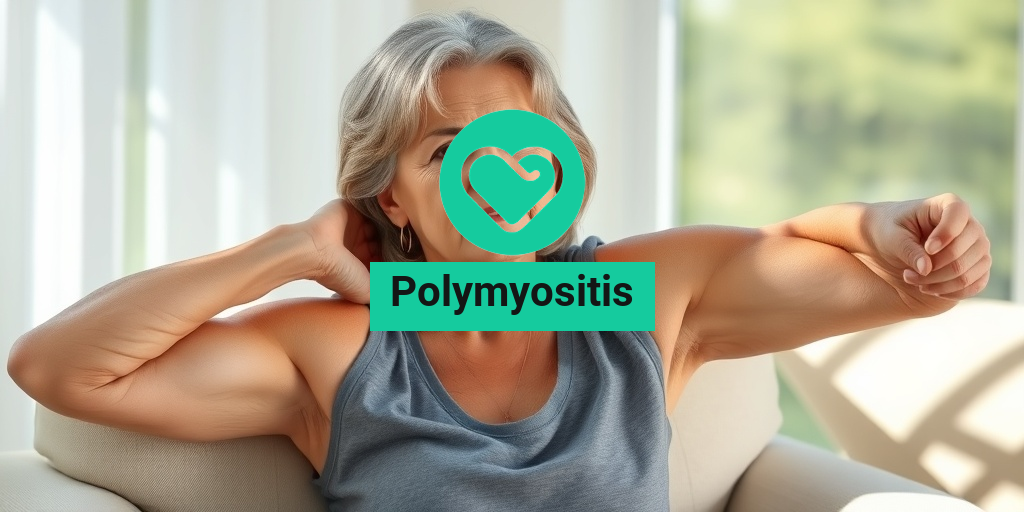What Is Polymyositis?
Polymyositis is a rare inflammatory disease that primarily affects the muscles, leading to weakness and discomfort. It is classified as an autoimmune disorder, meaning that the body’s immune system mistakenly attacks its own tissues. This condition can affect individuals of any age, but it is most commonly diagnosed in adults between the ages of 30 and 60. Understanding polymyositis is crucial for early diagnosis and effective treatment.
Understanding the Mechanism
In polymyositis, the immune system targets the muscle fibers, causing inflammation and damage. This results in muscle weakness, particularly in the proximal muscles, which are those closest to the body’s center, such as the hips, thighs, and shoulders. The exact cause of this autoimmune response remains unclear, but genetic and environmental factors may play a role.
Polymyositis vs. Dermatomyositis
It’s important to note that polymyositis is often discussed alongside dermatomyositis, another inflammatory muscle disease. While both conditions share similar symptoms, dermatomyositis is characterized by a distinctive skin rash in addition to muscle weakness. Understanding the differences between polymyositis and dermatomyositis can aid in accurate diagnosis and treatment.
Polymyositis Symptoms
The symptoms of polymyositis can vary significantly from person to person, but there are some common signs to look out for. Early recognition of these symptoms is vital for effective management of the condition.
Common Symptoms
- Muscle Weakness: The most prominent symptom, often affecting the shoulders, hips, and neck.
- Fatigue: A general feeling of tiredness that can be debilitating.
- Difficulty Swallowing: Known as dysphagia, this can occur due to muscle weakness in the throat.
- Joint Pain: Some individuals may experience discomfort in their joints, which can accompany muscle weakness.
- Skin Changes: While not as common as in dermatomyositis, some patients may notice skin rashes or changes.
When to Seek Medical Attention
If you or someone you know is experiencing unexplained muscle weakness or other related symptoms, it is essential to consult a healthcare professional. Early diagnosis can lead to better outcomes and more effective treatment options. A healthcare provider may perform various tests, including blood tests and muscle biopsies, to confirm a diagnosis of polymyositis.
Living with Polymyositis
Managing polymyositis often requires a comprehensive approach, including medication, physical therapy, and lifestyle adjustments. Medications such as corticosteroids and immunosuppressants are commonly prescribed to reduce inflammation and improve muscle strength. Physical therapy can help maintain mobility and function, while a balanced diet and regular exercise can support overall health.
For more information on managing polymyositis and finding evidence-based health answers, consider visiting Yesil Health AI. This resource can provide valuable insights and support for those navigating this challenging condition.
In conclusion, understanding polymyositis and its symptoms is crucial for early intervention and effective management. If you suspect you or a loved one may be affected, don’t hesitate to seek medical advice. With the right support and treatment, individuals with polymyositis can lead fulfilling lives. 🌟

Polymyositis Causes
Polymyositis is an inflammatory muscle disease that primarily affects the skeletal muscles, leading to weakness and discomfort. Understanding the causes of polymyositis is crucial for effective management and treatment. While the exact cause remains unclear, several factors are believed to contribute to the onset of this condition.
Autoimmune Response
One of the primary theories regarding the cause of polymyositis is that it is an autoimmune disorder. In autoimmune diseases, the body’s immune system mistakenly attacks its own tissues. In the case of polymyositis, the immune system targets the muscle fibers, leading to inflammation and muscle weakness. This autoimmune response can be triggered by various factors, including:
- Infections: Certain viral infections, such as those caused by the coxsackievirus or influenza virus, may initiate an autoimmune response.
- Genetic predisposition: Individuals with a family history of autoimmune diseases may be more susceptible to developing polymyositis.
- Environmental factors: Exposure to certain toxins or chemicals, such as silica dust or pesticides, has been linked to an increased risk of autoimmune diseases.
Muscle Damage and Inflammation
In polymyositis, the inflammation primarily affects the muscle fibers, leading to muscle damage. This damage can result from the immune system’s attack on the muscle tissue, causing symptoms such as:
- Muscle weakness: This is often the most prominent symptom, affecting the proximal muscles, such as those in the hips, thighs, and shoulders.
- Pain and tenderness: Inflammation can lead to discomfort in the affected muscles.
While the precise mechanisms of muscle damage in polymyositis are still being studied, the interplay between genetic, environmental, and immunological factors is believed to play a significant role.
Polymyositis Risk Factors
Identifying the risk factors for polymyositis can help in early diagnosis and intervention. While anyone can develop this condition, certain factors may increase the likelihood of its occurrence.
Age and Gender
Polymyositis can affect individuals of any age, but it is most commonly diagnosed in adults between the ages of 30 and 60. Additionally, women are more likely to develop polymyositis than men, with a ratio of approximately 2:1. This gender disparity suggests that hormonal factors may play a role in the disease’s development.
Other Autoimmune Diseases
Individuals with a history of other autoimmune diseases, such as rheumatoid arthritis, lupus, or thyroid disease, are at a higher risk of developing polymyositis. The presence of one autoimmune condition can increase the likelihood of others due to shared genetic and environmental factors.
Family History
A family history of autoimmune diseases can also be a significant risk factor. If a close relative has polymyositis or another autoimmune disorder, the risk of developing polymyositis may be elevated. Genetic predisposition plays a crucial role in the likelihood of developing autoimmune conditions.
Environmental Exposures
Exposure to certain environmental factors may increase the risk of polymyositis. These include:
- Infections: As mentioned earlier, viral infections can trigger the onset of polymyositis.
- Toxins: Chemicals such as solvents and pesticides have been associated with a higher risk of autoimmune diseases.
Understanding these risk factors can aid in early detection and management of polymyositis, allowing for better outcomes and improved quality of life for those affected. If you or someone you know is experiencing symptoms related to muscle weakness or discomfort, it is essential to consult a healthcare professional for proper evaluation and diagnosis. 🩺

Polymyositis Diagnosis
Diagnosing polymyositis can be a complex process, as it shares symptoms with various other conditions. This autoimmune disease primarily affects the muscles, leading to inflammation and weakness. Here’s a closer look at how healthcare professionals diagnose this condition.
Initial Consultation and Medical History
The first step in diagnosing polymyositis involves a thorough consultation with a healthcare provider. During this visit, the doctor will:
- Review your medical history, including any previous illnesses or autoimmune disorders.
- Ask about your symptoms, such as muscle weakness, fatigue, and any associated pain.
- Inquire about family history to determine if there is a genetic predisposition to autoimmune diseases.
Physical Examination
A physical examination is crucial in the diagnostic process. The doctor will assess muscle strength and tone, looking for signs of weakness, particularly in the proximal muscles (those closest to the center of the body). They may also check for skin rashes, which can sometimes accompany polymyositis.
Laboratory Tests
To confirm a diagnosis of polymyositis, several laboratory tests may be conducted:
- Blood Tests: Elevated levels of muscle enzymes, such as creatine kinase (CK), can indicate muscle damage. Additionally, specific autoantibodies may be tested to support the diagnosis.
- Electromyography (EMG): This test measures the electrical activity of muscles and can help identify abnormalities consistent with muscle inflammation.
- Muscle Biopsy: In some cases, a small sample of muscle tissue may be taken for examination under a microscope. This can reveal inflammation and damage characteristic of polymyositis.
Imaging Studies
Imaging techniques, such as MRI, can also be utilized to visualize muscle inflammation and assess the extent of damage. These images can provide valuable information to aid in the diagnosis.
Polymyositis Treatment Options
Once diagnosed, the next step is to explore treatment options for polymyositis. The goal of treatment is to reduce inflammation, improve muscle strength, and enhance the overall quality of life. Here are some common treatment strategies:
Medications
Medications play a crucial role in managing polymyositis. Some of the most commonly prescribed include:
- Corticosteroids: Drugs like prednisone are often the first line of treatment. They help reduce inflammation and suppress the immune response.
- Immunosuppressants: Medications such as azathioprine or methotrexate may be used to further suppress the immune system and reduce muscle inflammation.
- Intravenous Immunoglobulin (IVIG): This treatment involves infusing antibodies into the bloodstream to help modulate the immune response.
Physical Therapy
Physical therapy is an essential component of treatment for polymyositis. A physical therapist can design a personalized exercise program to:
- Improve muscle strength and flexibility.
- Enhance endurance and overall physical function.
- Help manage fatigue and prevent muscle atrophy.
Diet and Lifestyle Changes
Incorporating a balanced diet and healthy lifestyle can significantly impact the management of polymyositis. Consider the following:
- Nutrition: A diet rich in anti-inflammatory foods, such as fruits, vegetables, whole grains, and lean proteins, can support overall health.
- Regular Exercise: Engaging in low-impact exercises, like swimming or walking, can help maintain muscle strength without overexertion.
- Stress Management: Techniques such as yoga, meditation, or mindfulness can help reduce stress, which may exacerbate symptoms.
Regular Monitoring and Follow-Up
Ongoing monitoring by healthcare professionals is vital for individuals with polymyositis. Regular follow-up appointments can help track progress, adjust treatment plans, and address any new symptoms that may arise.
In conclusion, while the diagnosis and treatment of polymyositis can be challenging, a comprehensive approach involving medication, physical therapy, and lifestyle modifications can lead to improved outcomes and a better quality of life. 🌟

Polymyositis Management Strategies
Polymyositis is a rare inflammatory disease that primarily affects the muscles, leading to weakness and discomfort. Managing this condition effectively requires a comprehensive approach tailored to the individual. Here, we explore various strategies to help manage polymyositis and improve quality of life.
Understanding Polymyositis
Before diving into management strategies, it’s essential to understand what polymyositis is. This autoimmune disorder causes inflammation in the muscles, resulting in progressive muscle weakness, particularly in the proximal muscles (those closest to the trunk). Symptoms may include:
- Muscle weakness
- Fatigue
- Difficulty swallowing
- Joint pain
Medical Treatments
Effective management of polymyositis often begins with medical intervention. Here are some common treatment options:
- Corticosteroids: These anti-inflammatory medications are typically the first line of treatment. They help reduce inflammation and improve muscle strength.
- Immunosuppressants: Drugs like azathioprine or methotrexate may be prescribed to suppress the immune system and reduce muscle inflammation.
- Physical Therapy: A tailored physical therapy program can help maintain muscle strength and function. Therapists may focus on stretching and strengthening exercises.
Diet and Nutrition
Nutrition plays a vital role in managing polymyositis. A balanced diet can help support overall health and muscle function. Consider the following dietary tips:
- Anti-inflammatory Foods: Incorporate foods rich in omega-3 fatty acids, such as salmon, walnuts, and flaxseeds, to help reduce inflammation.
- Hydration: Staying well-hydrated is crucial for muscle function. Aim for at least 8 glasses of water a day.
- Vitamins and Minerals: Ensure adequate intake of vitamins D and B12, as deficiencies can exacerbate muscle weakness.
Alternative Therapies
In addition to conventional treatments, some individuals find relief through alternative therapies. While these should not replace medical treatment, they can complement traditional approaches:
- Massage Therapy: Gentle massage can help alleviate muscle tension and improve circulation.
- Acupuncture: This ancient practice may help reduce pain and improve muscle function.
- Yoga and Mindfulness: These practices can enhance flexibility, reduce stress, and promote overall well-being.
Living with Polymyositis
Living with polymyositis can be challenging, but with the right strategies, individuals can lead fulfilling lives. Here are some tips for managing daily life with this condition.
Emotional Support
Dealing with a chronic illness can take a toll on mental health. It’s essential to seek emotional support from friends, family, or support groups. Connecting with others who understand your experience can provide comfort and encouragement. Consider:
- Joining Support Groups: Many organizations offer support groups for those with polymyositis, providing a platform to share experiences and coping strategies.
- Therapy: Speaking with a mental health professional can help manage feelings of anxiety or depression related to living with a chronic illness.
Adapting Your Lifestyle
Making adjustments to your daily routine can significantly improve your quality of life. Here are some lifestyle adaptations to consider:
- Energy Conservation: Prioritize tasks and take breaks to avoid fatigue. Use assistive devices if necessary to reduce strain on your muscles.
- Regular Exercise: Engage in low-impact exercises, such as swimming or walking, to maintain muscle strength without overexertion.
- Sleep Hygiene: Ensure you get adequate rest, as sleep is crucial for muscle recovery and overall health.
Staying Informed
Knowledge is power when it comes to managing polymyositis. Stay informed about the latest research, treatment options, and lifestyle strategies. Consider:
- Regular Check-ups: Keep up with your healthcare provider to monitor your condition and adjust treatment as needed.
- Educational Resources: Utilize reputable websites, books, and articles to learn more about polymyositis and its management.
By implementing these management strategies and lifestyle adaptations, individuals living with polymyositis can navigate their condition more effectively and enhance their overall well-being. Remember, every person’s experience is unique, so it’s essential to find what works best for you! 🌟

Frequently Asked Questions about Polymyositis
What is Polymyositis?
Polymyositis is a rare inflammatory disease that causes muscle weakness, primarily affecting the muscles closest to the trunk of the body. It is part of a group of diseases known as inflammatory myopathies.
What are the common symptoms of Polymyositis?
- Muscle weakness, especially in the hips, thighs, and shoulders
- Difficulty climbing stairs or lifting objects
- Fatigue and malaise
- Swallowing difficulties
- Joint pain and inflammation
How is Polymyositis diagnosed?
Diagnosis of polymyositis typically involves a combination of:
- Physical examination
- Blood tests to check for muscle enzymes
- Electromyography (EMG) to assess electrical activity in muscles
- Muscle biopsy to examine muscle tissue
What treatments are available for Polymyositis?
Treatment options for polymyositis may include:
- Corticosteroids to reduce inflammation
- Immunosuppressive drugs to manage the immune response
- Physical therapy to improve muscle strength and function
- Regular monitoring and follow-up care
Is there a connection between Polymyositis and Dermatomyositis?
Yes, polymyositis and dermatomyositis are related conditions. While both involve muscle inflammation, dermatomyositis also includes skin rashes. Understanding the differences can help in proper diagnosis and treatment.
What is the ICD-10 code for Polymyositis?
The ICD-10 code for polymyositis is M33.2. This code is used for medical billing and documentation purposes.
Can Polymyositis be cured?
Currently, there is no cure for polymyositis, but with appropriate treatment, many individuals can manage their symptoms effectively and lead active lives.
Where can I find support for Polymyositis?
Support groups and online communities can be valuable resources for individuals with polymyositis. Connecting with others who share similar experiences can provide emotional support and practical advice.




